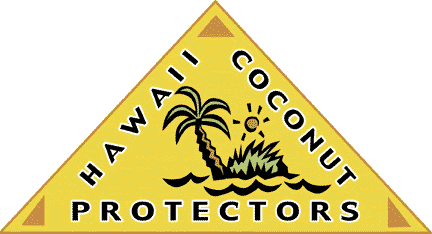

Battling Coconut Heart Rot
Don't miss an informational program about
the Coconut Heart Rot Disease on
Akaku: Maui public Cable TV Station:
Channel # 44 most of Maui, # 52 West side, # 13 Molokai and Lanai.
Friday September 8 at: 12.45 pm
Saturday September 9 at : 3.20 pm
Tuesday September 19 at : 1.20 pm
Wednesday September 20 at 5.50 pm
Monday September 25 at 6.45 pm
Monday October 2 at: 9.45 pm
Thursday October 12 at 5.15 pm
All photos can be clicked on to view larger images (sizes 40K to 70K).

Maui Time
September 12, 2000
>>>>>>>>>>>>>>>>>>>>>>>>>>>>>>>>>>>>>>>>
by Olivia Techoueyres
Hawai`i's tropical image is often portrayed by its beautiful white sand beaches and magnificent swaying coconut trees. These trees are also a symbol of the visitor industry and are used widely for landscaping parks, roadways, business districts, hotels, golf courses, scenic vistas, and residences. Besides their beauty, "the tree of life" provided a valuable source of food and building materials for the Hawaiians and other islanders. Unfortunately, the future of coconut trees in the islands is bleak, because of a devastating disease that is killing them at an alarming rate.
This disease, known as "coconut heart rot", is caused by the fungus Phytophthora katsurae. The pathogen was first identified in the 1970 by the University of Hawai`i (UH) on Kaua`i. The disease started on the windward side of the Islands with the loss of few trees. Nobody got alarmed because it seemed to spread slowly and was attributed to the wetness of the location. However in the last few years, coconut palms have died in great numbers on the windward side despite the unusual droughts.
On Maui, approximately 20 percent of the coconut trees have died. Scattered outbreaks are now beginning to occur in the drier areas of
central, south and west Maui. The disease has also become an epidemic in Kaua`i, O`ahu and the Big Island.
The dead palm shown on the cover, a victim of the disease, is located at the North Kihei Road entrance to Kihei. Infected trees have also
been found in Kahului, Wailuku, Kihei, Wailea, Makena, Lahaina, Ka`anapali, Napili, Kapalua. Experts are realizing that the disease is
now on the leeward side of the Islands, and the daily irrigation combined with the strong heat of the day will help the fungus thrive.
 Although no one really knows how this fungus got to Hawai`i, most scientists believe that it is spread by strong windblown rains,
through insects, birds, and mice, or by pruning and planting infected trees. The infection is carried by a given agent (rain, insects, etc.)
to the top of a nearby healthy tree where the fungus then moves down into the heart of the palm, producing a rot that slowly destroys the
growing shoot and kills the plant.
Although no one really knows how this fungus got to Hawai`i, most scientists believe that it is spread by strong windblown rains,
through insects, birds, and mice, or by pruning and planting infected trees. The infection is carried by a given agent (rain, insects, etc.)
to the top of a nearby healthy tree where the fungus then moves down into the heart of the palm, producing a rot that slowly destroys the
growing shoot and kills the plant.
The first visible symptom of coconut heart rot is the death of the young center leaf, which turns brown and falls over. As the rot advances, other remaining fronds slowly droop and die. Eventually, the top of the tree falls off... leaving what looks like an abandoned pole. Another possible symptom is the appearance of a stem end rot on young developing nuts, which causes them to fall prematurely. The dreadful thing about this disease is that once external symptoms are displayed, the heart of the palm is already rotten and the tree can no longer be saved. Furthermore, if the infected tree is not immediately removed and properly disposed, the fungus can easily spread to neighboring palms.
As precaution, experts recommend the following: never prune healthy trees if you suspect your tools (pruners, knives, etc.), equipment
(chain saws, ladders or lifts, truck beds, etc.), or any other materials (hands, gloves, shoes, clothing, etc.) may have been contaminated
with the fungus. Thoroughly wash, clean, or disinfect these items with a 20% solution of Clorox, or 70% Isopropyl rubbing alcohol to
avoid spreading the disease. Once a dead tree has been cut down, it should be immediately buried, burned (fire permit may be required),
or taken to the landfill. When hauling a diseased tree, it must be properly wrapped or covered to prevent any infected tissues or insects
from spreading along the roadway, thereby causing new outbreaks in other locations.
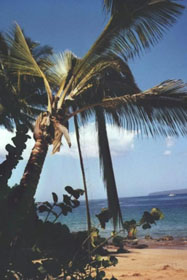 |
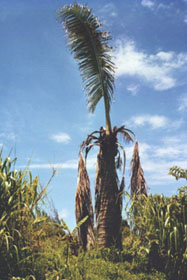 |
| Makena | Final stage |
Preliminary research conducted on Kaua`i by the university showed that disease protection was being achieved by injection into the trunk of coconut trees. Unfortunately, this experiment was destroyed by Hurricane Iniki before the final results could be taken.
In an effort to save Hawai`i's coconut trees, the Hawai`i Farm Bureau Federation, Department of Agriculture, University of Hawai`i, Maui Association of Landscape Professionals, Hawai`i Organic Farmers Association, several Hotel Associations, and the County of Maui are supporting a funding request to the State Legislature to enable UH to finalize its research on this disease.
In the meantime, an education and injection program has been put together by Hawai`i Coconut Protectors to help protect the palms from contracting the disease. Seminars, Presentations to both the Landscaping and Tourism Industry have been held. Many private owners, hotels and resorts, golf courses, restaurants, condos have already protected their trees. The collaboration and support of residents is needed to stop the further spread of the disease. Because of the large population of coconut palms, as well as the fact that they do not show any outside noticeable symptoms until they are dead and usually cut down, the disease has been allowed to spread and remain unnoticed to the untrained eye. The reality is that we are starting to see landscaping like that of the picture on top, taken on the windward side of Maui. If we wait any longer, we will not be able to save our island heritage...
Information about the coconut heart rot may be obtained by visiting coconutprotectors.com or calling (808) 573-1850.
 |
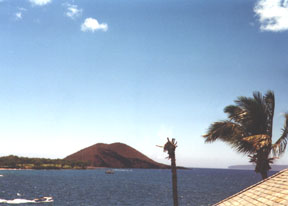 |
| Hana Bay | Makena |
Maui Island Weekly, May 11-17, 2000
By Gene Thompson
If any one thing symbolizes the magic of the Hawaiian Islands, it is the coconut palm. Our visitor advertising is saturated with photos and drawings of these graceful trees. Besides their beauty, "the tree of life" provided a valuable source of food and building materials for Hawaiians and other islanders.
And despite their delicate appearance, coconut palms are among the strongest of trees, holding up in storms that wreak destruction all around them. Yet even the coconut palm is no match for the dread coconut heart rot disease that has come to Hawaii and Maui.
The disease started in the 1980's on the windward sides of the islands where its growth was aided by the heavier rainfall there. In the 1990's the disease began to appear in the arid areas of Maui. The dead palm in the photo below, a victim of the disease, is located at the North Kihei Road entrance to Kihei. Infected trees have been found in Maui Meadows, Wailea and West Maui.
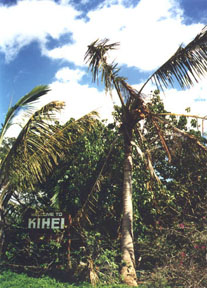 |
According to Visintainer of Hawaii Coconut Protectors, the disease is now epidemic in Hawaii. He said the University of Hawaii estimates it has killed 20 to 25% of the coconut palms on Maui's north shore. The disease spreads in aerosol droplets, by insects, driving rain, infected tree stock and contaminated tools.
His company, Hawaii Coconut Protectors, and the University of Hawaii suggest a four-step approach for dealing with coconut heart rot disease. The first is education - recognizing diseased trees. To prevent its further spread, all pruning tools should be thoroughly disinfected with alcohol or chlorine bleach. Healthy trees can be given some protection by injection. Finally, all infected trees and their rubbish should be removed and burned or buried.
Terry Nutt of the Maui Association of Landscape Professionals suggested that we can increase the disease resistance of the trees by keeping them as healthy as possible. Of course, that advice applies to all plants.
Information about the coconut heart rot disease may be obtained by calling Philippe Visintainer at 573-1850.
 |
 |
| Airport 1 | Airport 2 |
Mr. Philippe Visintainer
Director, Maui County Farm Bureau
Dear Mr. Visintainer:
SUBJECT: HEART ROT OF COCONUT
I wish to express my support of the request by the Maui Association of Landscape Professionals to appropriate $10,000 to continue the research and treatment of the Heart Rot of Coconut.
On Maui, about 20-25% of the coconut palms on the north shore have died because of this disease. On newly infected trees, the rot occurs internally with no visible external symptoms, which makes diagnosis and eradication extremely difficult.
Based on previous work by the University of Hawaii, it has been shown that injecting a systemic fungicide into the trunk of healthy trees will protect them from this infection. Without funds to treat this disease, many of our coconut trees will die. Because of the potential harm of this disease, Maui County strongly supports the appropriation of $10,000 to effectively treat and eradicate the Heart Rot disease.
Thank you for providing me with the opportunity to provide our comments on this important matter. Should you require additional information, please let me know. I would also appreciate being informed of the progress of this appropriation request.
Very truly yours,
JAMES "KIMO" APANA
Mayor, County of Maui
 |
 |
| Baldwin Beach 1 | Baldwin Beach 2 |
MAUI HOTEL ASSOCIATION
Philippe Visintainer
Maui County Farm Bureau
P.O. Box 1314
Paia, HI 96779
RE: Heart Rot of Coconut
The Maui Hotel Association supports the research efforts for controlling this above-mentioned disease of the Coconut Palm. Obviously, part of who we are in Hawaii is about the swaying Coconut trees and we must do what we can to protect our trees. The visitors expect to see palm trees and we would most certainly lose an important part of our vistas without swaying palms. We will support the bill going before the legislature to encumber $10,000 for continued research in Heart Rot Disease.
Sincerely,
Teryl Vencl
Executive Director
Maui Hotel Association
 |
 |
| Banyan Tree, Lahaina | Ala Moana Park |
A serious fungal disease caused by phytophora katsurae is spreading over the Hawaiian islands. Coconut bud rot, which was mostly occurring on the windward sides, is now an epidemic affecting the leeward side as well. Diagnosis and disease eradication are extremely difficult. On newly infected trees, a rot occurs internally, with no visible external symptoms. Once external symptoms are displayed, the infected tree is already dead, and the disease may have spread to other nearby plants.
Unfortunately, the control work on coconut bud rot was never quite completed, so nothing was published on the procedures for protecting the trees with injectable fungicides.
Besides the nature of the host and disease, among the problems associated with this project were the reluctance to support the work, damage to the field experiments caused by Hurricane Iniki, and insufficient funding to continue. Research money to complete the work and find a cure for the disease is now being requested through a bill at Legislature 2000.
MHA is supporting this measure. In the meantime, an education and injection program has been put together by Hawai'i Coconut Protectors, to help protect the palms from contracting the disease.
The injection will help protect the palms for a period of 9 months to 1 years.
We recommend this procedure be done once a year, until a cure is found for the disease.
The cost of the injection is $20 per tree, $15 for 50 or more trees.
This disease is now spreading on the west and south side of the island.
You can see dead trees with the same symptoms in Lahaina: by the banyan
tree, the tennis courts, in some proprietes along the ocean, in some of
Ka'anapali, and Napili Hotels and Condos.
In Kihei, by the welcome to Kihei entrance sign, along the beach on north Kihei road, in some properties and beach parks, along the south Kihei road, in Maui Meadow, and in some Hotels, Resorts and condos.
Hawaii Coconut Protectors
P.O. Box 1314
Paia, HI 96779
Phone: 808-573-1850
Fax: 808-572-5036
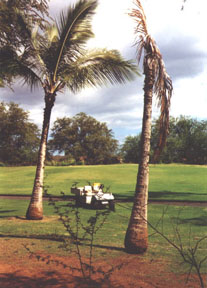 |
Hawaii Coconut Protectorsemail: coconut@mauigateway.com |
 |
| Golf Course | Ka'anapali |
All photos can be clicked on to view larger images (sizes 40K to 70K).
 |
 |
 |
 |
 |
| Kahului | Kuau | MCC | Road to Hana | Sprecks |
 |
 |
 |
 |
 |
| Final stage | Golf Course | Heart rot | Heart rot 2 | Honolulu |
 |
 |
 |
 |
|
| Olowalu | Kahului 2 | Kihei condo | Lahaina | Lahaina 2 |